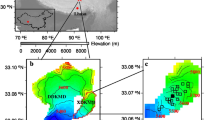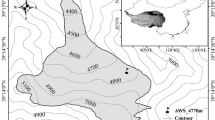Abstract
Based on the field observations on Qiyi Glacier during the warm season of 2007, using a digital elevation model (DEM, 15 m resolution), we developed a distributed surface energy- and mass-balance model with an hourly resolution. The model described the effect of topography on shortwave solar radiation, and used a new parameterization for glacier albedo. The model was applied to Qiyi Glacier in the Qilian Mountain, China, for the period 20: 00 30 June to 12: 00 10 October 2007, to simulate the firn-line changes, the temporal and spatial variations of mass balance, and the glacial meltwater runoff. The results indicated that the patterns of altitudinal profile of glacier mass-balance were affected mainly by the altitudinal profile of albedo, and the status of the glacier mass balance was influenced directly by the values of albedo. The parameter sensitivity test showed that the model was sensitive to the air temperature lapse rate and precipitation gradient, and also sensitive to the threshold temperature for solid/liquid precipitation. Furthermore, the climate sensitivity test showed that the mass balance was more sensitive to air temperature than precipitation, and the response of mass balance to air temperature change was nonlinear while the response to precipitation change linearly. The negative mass balance trend of the glacier can not be reversed when precipitation increases by 20% and meanwhile air temperature rises by 1°C.
Similar content being viewed by others
References
Xie Z. Mass balance of glaciers and its relationship with characteristics of glaciers (in Chinese). J Glaciol Geocryol, 1980, 2: 1–10
Oerlemans J. Climate sensitivity of glaciers in southern Norway: Application of an energy-balance model to Nigardsbreen, Hellstugubreen and Alfotbreen. J Glaciol, 1992, 38: 223–232
Klok E J, Oerlemans J. Model study of the spatial distribution of the energy and mass balance of Morteratschgletscher, Switzerland. J Glaciol, 2002, 48: 505–518
Steffen K. Surface energy exchange at the equilibrium line on the Greenland ice sheet during onset of melt. Ann Glaciol, 1995, 21: 13–18
Escher-Vetter H. Energy balance calculations for the ablation period 1982 at Vernagtferner, Oetzal Alps. Ann Glaciol, 1985, 6: 158–160
Gardiner M J, Ellis-Evans J C, Anderson M G, et al. Snowmelt modelling on Signy Island, South Orkney Islands. Ann Glaciol, 1998, 26: 161–166
Ma H, Liu Z, Liu Y. Energy balance of a snow cover and simulation of snowmelt in the western Tianshan Mountains, China. Ann Glaciol, 1991, 16: 73–78
Ohta T. A distributed snowmelt prediction model in mountain areas based on an energy balance method. Ann Glaciol, 1994, 19: 107–113
Zuo Z, Oerlemans J. Modelling albedo and specific balance of the Greenland ice Sheet: Calculations for the Søndre Strømfjord transect. J Glaciol, 1996, 42: 305–317
Hock R. A distributed temperature-index ice- and snowmelt model including potential direct solar radiation. J Glaciol, 1999, 45: 101–111
Hock R. Temperature index melt modelling in mountain areas. J Hydrol, 2003, 282: 104–115
Braithwaite R J. Positive degree-day factors for ablation on the Greenland ice sheet studied by energy-balance modelling. J Glaciol, 1995, 41: 153–160
Braithwaite R J, Zhang Y. Sensitivity of mass balance of five Swiss glaciers to temperature changes assessed by tuning a degree-day model. J Glaciol, 2000, 46: 7–14
Arnold N S, Willis I C, Sharp M J, et al. A distributed surface energy-balance model for a small valley glacier. I. Development and testing for Haut Glacier d’Arolla, Valais, Switzerland. J Glaciol, 1996, 42: 77–89
Braithwaite R J, Konzelmann T, Marty C, et al. Reconnaissance study of glacier energy balance in North Greenland, 1993–94. J Glaciol, 1998, 44: 239–247
Brock B W, Willis I C, Sharp M J, et al. Modelling seasonal and spatial variations in the surface energy balance of Haut Glacier d’Arolla, Switzerland. Ann Glaciol, 2000, 31: 53–62
Hock R, Holmgren B. A distributed surface energy-balance model for complex topography and its application to Storglaciären, Sweden. J Glaciol, 2005, 51: 25–36
Andreassen L M, Van Den Broeke M R, Giesen R H, et al. A 5-year record of surface energy and mass balance from the ablation zone of Storbreen, Norway. J Glaciol, 2008, 54: 245–258, doi: 10.3189/002214308784886199
Hock R. Glacier melt: A review of processes and their modelling. Prog Phys Geog, 2005, 29: 362–391
Zhang Y, Liu S. Progress of the application of degree-day model to study glaciers and snow cover (in Chinese). J Glaciol Geocryol, 2006, 28: 101–107
Zhang Y, Liu S Y, Ding Y J, et al. Preliminary study of mass balance on the Keqicar Baxi Glacier on the south slopes of Tianshan Mountains (in Chinese). J Glaciol Geocryol, 2006, 28: 477–484
Zhang Y, Liu S Y, ShangGuan D H, et al. Study of the positive degree-day factors on the Koxkar Baqi Glacier on the south slope of Tianshan Mountains (in Chinese). J Glaciol Geocryol, 2005, 27: 337–343
Liu S Y, Ding Y J, Wang N L, et al. Mass balance sensitivity to climate change of the Glacier No. 1 at the Urumqi River Head, Tianshan Mts. (in Chinese). J Glaciol Geocryol, 1998, 20: 9–13
Brubaker K, Rango A, Kustas W. Incorporating radiation inputs into the snowmelt runoff model. Hydrol Process, 1996, 10: 1329–1343
Dadic R, Corripio J G, Burlando P. Mass-balance estimates for Haut Glacier d’Arolla, Switzerland, from 2000 to 2006 using DEMs and distributed mass-balance modeling. Ann Glaciol, 2008, 49: 22–26
Reijmer C H, Hock R. Internal accumulation on Storglaciaren, Sweden, in a multi-layer snow model coupled to a distributed energy- and mass-balance model. J Glaciol, 2008, 54: 61–72
Fujita K, Ageta Y. Effect of summer accumulation on glacier mass balance on the Tibetan Plateau revealed by mass-balance model. J Glaciol, 2000, 46: 244–252
Pu J, Yao T, Duan K, et al. Mass balance of the Qiyi Glacier in the Qilian Mountains: A New Observation (in Chinese). J Glaciol Geocryol, 2005, 27: 199–204
Yang D, Shi Y, Kang E, et al. Research on analysis and correction of systematic errors in precipitation measurement in Urumqi River basin, Tianshan. In: Proceedings of the International Workshop on Precipitation Measurement, St. Moritz, Switzerland, 1989. 173–179
Yang D, Shi Y, Kang E, et al. Results of solid precipitation measurement intercomparison in the alpine area of Urumqi River Basin. Chinese Sci Bull, 1991, 36: 1105–1109
Li X, Cheng G D, Chen X Z, et al. Modification of solar radiation model over rugged terrain. Chinese Sci Bull, 1999, 44: 1345–1349
Oerlemans J. Analysis of a 3 year meteorological record from the ablation zone of Morteratschgletscher, Switzerland: Energy and mass balance. J Glaciol, 2000, 46: 571–579
Greuell W, Oerlemans J. Sensitivity studies with a mass balance model including temperature profile calculations inside the glacier. Z Gletscherkd Glazialgeo, 1986, 22: 101–124
Mölg T, Hardy D R. Ablation and associated energy balance of a horizontal glacier surface on Kilimanjaro. J Geophys Res, 2004, 109, doi: 10.1029/2003JD004338
Bintania R, Van Den Broete M R. The surface energy balance of Antarctic snow and blue ice. J Appl Meteorol, 1995, 34: 902–926
Wagnon P, Ribstein P, Kaser G, et al. Energy balance and runoff seasonality of a Bolivian glacier. Global Planet Change, 1999, 22: 49–58
Kondo J, Yamazawa H. Bulk transfer coefficient over a snow surface. Bound-Lay Meteorol, 1986, 34: 123–135
Shi Y F, Huang M H, Ren B H. An Introduction to the Glaciers in China (in Chinese). Beijing: Science Press, 1988. 29–54
De Ruyter De Wildt M S, Oerlemans J, Björnsson H. A method for monitoring glacier mass balance using satellite albedo measurements: Application to Vatnajökull, Iceland. J Glaciol, 2002, 48: 267–278
Wang N L, Zhang S B, He J Q, et al. Tracing the major source area of the mountainous runoff generation of the Heihe River in northwest China using stable isotope technique. Chinese Sci Bull, 2009, 54: 2751–2757
Wang N L, Yao T D, Tian L D, et al. Climate sensitivity of glacier No.1 at the source of Urumqi River in the Tianshan Mountains (in Chinese). Arid Land Geogr, 1998, 21: 34–40
Wang N L, Zhou Y B. A new Approach of analyzing the influence of climate change on the ELA: Application of grey theory in glaciology (in Chinese). In: Proceeding of the Fifth Chinese Conference on Glaciology and Geocryology (Vol.1). Lanzhou: Gansu Culture Press, 1996. 205–212
Wang N L. Grey relational analysis of the leading climatic factor influencing the changes of equilibrium line (in Chinese). J Glaciol Geocryol, 1995, 17: 8–15
Shi Y F, Shen Y P, Hu R J. Preliminary study on signal, impact and foreground of climatic shift from warm-dry to warm-humid in Northwest China (in Chinese). J Glaciol Geocryol, 2002, 24: 219–226
Author information
Authors and Affiliations
Corresponding author
About this article
Cite this article
Jiang, X., Wang, N., He, J. et al. A distributed surface energy and mass balance model and its application to a mountain glacier in China. Chin. Sci. Bull. 55, 2079–2087 (2010). https://doi.org/10.1007/s11434-010-3068-9
Received:
Accepted:
Published:
Issue Date:
DOI: https://doi.org/10.1007/s11434-010-3068-9




